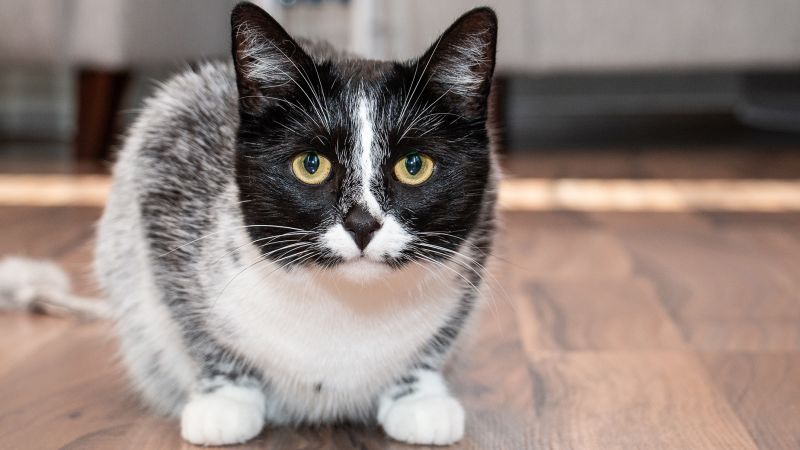Sign up for CNN’s Wonder Theory science newsletter. Explore the universe with news on fascinating discoveries, scientific advancements and more.
CNN
—
The village of Petäjävesi in central Finland is home to farmland, lakes, an 18th century wood-log church and a group of unusually striking cats. With their white chests, these creatures look similar to other tuxedo cats, but they possess a distinctive bit of flair: ombré strands of fur that start dark at the root and fade to white.
Geneticist Hannes Lohi and his collaborators at the University of Helsinki wanted to know how these cats got their look, so they studied the animals’ DNA. The team’s report, published May 9 in the journal Animal Genetics, found that a novel gene mutation gives rise to the exceptional fur pattern, which they dubbed salmiak, or “salty licorice,” after a popular Finnish treat.
The project was a collaboration between the university, which houses a biobank of 5,000 blood samples from more than 40 feline breeds, a pet care company that makes genetic tests, and cat owners and breeders who offered their companions’ DNA for research.
“Our research approach is community science,” Lohi, who was corresponding author on the study, told CNN. “Often, the research ideas also come from cat owners and breeders having found something interesting in their pets.”
In this case, people first observed the unusual white coloring among Petäjävesi’s cats in 2007. Lohi and his team collected samples from five of them and found that none exhibited the gene variations that typically give rise to white coloration.
To home in on the genetic cause, the researchers sequenced the full genome of two of the cats and discovered a previously unknown mutation that affects a particular gene called KIT.
Annakarin Veida/iStockphoto/Getty Images
Researchers dubbed the cats’ unusual coat coloring as salmiak, or “salty licorice,” after a popular Finnish candy.
The team called the gene variant w-sal, for salmiak — black licorice with a speckling of white salt. The researchers tested the salty colored cats and 178 normal-colored samples from the biobank for the new gene variant. Each of the five salmiak cats had two copies of the recessive gene. A few of the other cats had one copy (not resulting in the unique color), and the rest had none.
“One of the fascinating aspects of the study is that it uncovers a really sophisticated way in which this very important KIT gene is normally regulated,” said Greg Barsh, a professor of genetics at Stanford University, who was not involved in the research.
In addition to controlling hair color, the KIT gene encodes for proteins in red blood cells and the cells that become sperm and eggs. Sometimes gene variants that give cats (and dogs) white fur can also cause deafness, though that doesn’t seem to be the case with w-salmiak. It’s one of many ways in which gene mutations that affect hair color can cause issues in other parts of the body.
The larger goal of this and other biobank work, Lohi said, “is to understand the molecular and environmental causes of feline disorders.”
The University of Helsinki has several ongoing projects with Wisdom Panel, which makes pet DNA tests, to look at the genetics of different diseases. And since genes are often similar across mammal species, what Lohi and his team learn could help not just cats but also humans with related medical conditions. None of the study coauthors have a financial stake in Wisdom Panel, Lohi confirmed.
Now that salty licorice cats are officially a thing, could they become the next designer breed?
“It is possible that breeders will choose to develop a population of salty licorice cats,” Lohi said. “However, the health of the salty licorice cats should be followed in more detail to confirm the absence of any color-related health issues.” Tailored genetic testing could be used to ensure the cats are bred without passing on dangerous genes.
“If there are enough people out there that think, ‘Oh, this is really rare and they’re really cute,’ then it could become very popular,” Barsh said. “That is really more of a question having to do with the relationship of humans to companion animals than the science itself.”
Amanda Schupak is a science and health journalist in New York City.








:max_bytes(150000):strip_icc()/roundup-writereditor-loved-deals-tout-f5de51f85de145b2b1eb99cdb7b6cb84.jpg)


